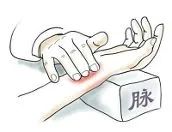“Doctor, I feel dizzy, and my left wrist pulse is very weak. On TV, they say a weak pulse indicates insufficient qi and blood in the body. Is my dizziness due to being too weak?” Indeed, her left pulse is weak, but her right pulse is strong and smooth. Is her body really deficient?

Pulse diagnosis is a unique diagnostic method in Traditional Chinese Medicine (TCM) that reflects the overall condition of the body’s organs and the state of qi and blood. Both a thin pulse and a weak pulse indicate insufficient qi and blood. However, does a weak pulse on one side necessarily signal weakness? TCM emphasizes the integration of the four diagnostic methods: observation, listening, inquiry, and palpation before drawing conclusions. Although this patient has a slightly sallow complexion, she is in good spirits, has a strong voice, and is quick to respond. She does not usually experience significant fatigue, shortness of breath, or spontaneous sweating, which are signs of qi and blood deficiency. Instead, she often feels tense, has headaches, overthinks, and suffers from constipation, all of which are manifestations of excessive liver yang. The sallow complexion is related to the physiological aging process in women, as described in TCM: “At the age of six or seven, the three yang pulses weaken, leading to a sallow complexion and early graying of hair.” Therefore, while this patient has some degree of “deficiency,” it is likely related to physiological aging rather than a pathological weakness.

Since the patient’s qi and blood deficiency is not severe, what is causing her weak pulse? An ultrasound of the neck vessels indicated possible left subclavian artery steal syndrome (Type II). It turns out that the reason for her weak pulse is an issue with the arterial supply to her limbs.

Subclavian artery steal syndrome refers to partial or complete occlusive damage in the proximal segment of the subclavian artery or the brachiocephalic trunk, which causes retrograde blood flow in the affected vertebral artery due to siphoning effects, leading to ischemic events in the vertebrobasilar system and ischemic symptoms in the affected upper limb. This condition is more common in men than in women, typically in individuals over 50 years of age. The most common symptoms of vertebrobasilar ischemia include dizziness, mild limb weakness, sensory abnormalities, visual disturbances, diplopia, and syncope. In rare cases, “drop attacks” may occur, characterized by sudden loss of strength in the lower limbs without warning, with no loss of consciousness and rapid recovery. Ischemic symptoms in the affected limb may include easy fatigue, soreness, coldness, and sensory abnormalities. Thus, subclavian artery steal syndrome poses a significant health risk.

Clinically, not all cases of subclavian artery steal syndrome present with the typical symptoms mentioned above. We can perform self-screening through the following methods: ① Check for diminished or absent pulse in one side’s radial artery; sometimes the brachial or subclavian artery pulses may also be diminished or absent. ② A significant drop in blood pressure in one upper limb, with a difference of more than 20 mmHg in systolic pressure between the two arms. Of course, accurate diagnosis still relies on vascular ultrasound, TCD, CTA, and DSA examinations.

The most common cause of subclavian artery steal syndrome is atherosclerosis. Therefore, it is recommended that individuals with risk factors for arterial sclerosis, such as hypertension, hyperlipidemia, diabetes, smoking, alcohol consumption, and advanced age, undergo regular vascular ultrasound examinations annually to facilitate early detection, timely medical intervention, and early treatment.

Content by ▏ Neurology Department, Zhang Yanan
Edited by ▏ Publicity Department
